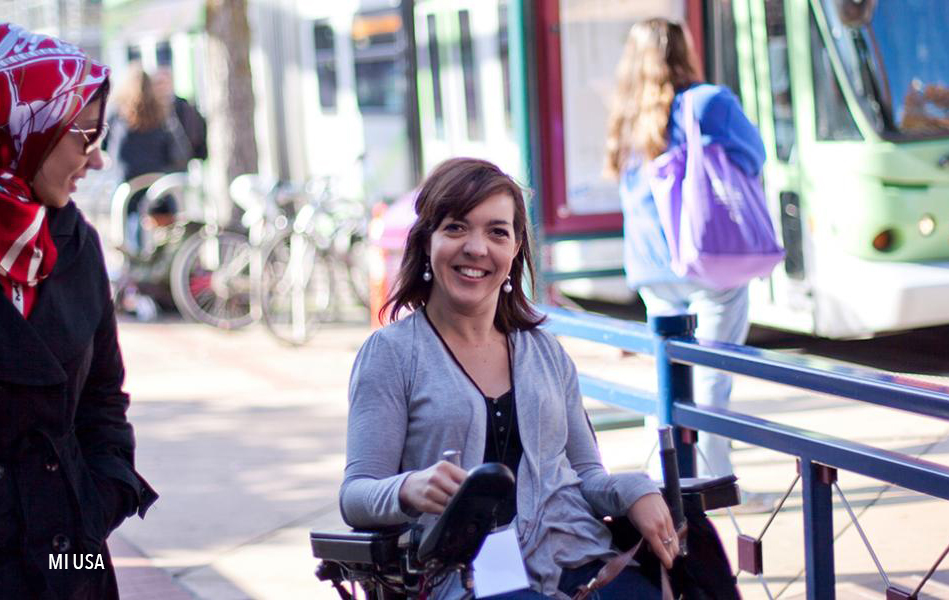
ADA: Opening Doors to Opportunity for 25 Years
The American Disabilities Act (ADA) should really be renamed the American Abilities Act, because that is its primary focus. The American Disabilities Act, passed in 1990, shifted America‟s viewpoint on those with disabilities. Instead of looking at what disabled people couldn‟t do, the ADA helped Americans to focus on what disabled people can do.
Prior to the passing of the ADA, being disabled was equivalent to being trapped in a cage. The world confined the disabled to their wheelchairs, to their walking canes, to their hearing aids, or to any other assistive devices. People could only travel as far as their disability could get them, and that wasn‟t very far. Society forced them to be hostages to their own impairments and often barred them from riding the bus, enjoying a movie or eating out at a restaurant. Barriers were everywhere. Small barriers such as sidewalk curbs or a flight of stairs prevented people from entering buildings. Larger barriers such as prejudiced employers or college admissions officers prevented disabled people from gaining what they need to be successful in life.
ADA helped liberate these prisoners. ADA fought for the implementation of equality in all areas of life such as work, government services, private businesses, and education. It restricted workplace discrimination and made it mandatory for employers to provide the necessary accommodations for their disabled workers. ADA made America more accessible to everybody. As a result, the height of curbs was reduced so that wheelchairs could navigate the sidewalks, closed captioning started appearing on televisions and movie screens so that everyone in the audience could understand the dialogue and the disabled finally gained a platform in which their voices could be heard. Yet, ADA didn‟t just improve accessibility for the disabled people, it also helped make the environment more user friendly for people of all abilities. For example, wheelchair ramps are a great help not only to paralyzed or disabled individuals, but also to delivery workers with heavy packages or mothers pushing baby strollers.
Furthermore, because of ADA everyone‟s voices were heard, even those who have invisible disabilities, such as epilepsy or a learning disability. It recognized a wide range of needs and more importantly, recognized a wide range of capabilities, skills, and possibilities.
The minimum cost of providing these accommodations pales in comparison with the priceless value of what these changes have wrought. In fact, “more than half of accommodations cost employers nothing, and of those that do cost, the typical one-time expenditure is $500,” according to the United States Department of Labor.With access to these types of facilities and accommodations, people with disabilities have been able to participate more in public life, and thrive. They now have greater access to enter the workforce and pursue their dreams.
This is the reason why my father, who is profoundly Deaf, is able to work at Chubbs Insurance and support my family. Because of ADA, Chubbs provided my father with a videophone as well as any other accommodations he needs to be productive, and as a result, my father has gotten multiple raises for his exceptional work performance.
By eliminating the barriers that held the disabled back before, the disabled have been able to efficiently showcase their top quality work. Another example of this was that I, as a disabled woman with a hearing loss, was able to get accepted into NYU. Not only was I not discriminated against in the admissions process, but I was also able to receive the accommodations I needed through the NYU Moses Center for Students with Disabilities. I was able to receive free stenography services for every class I attended. When I sit in large lecture classes and I cannot hear/understand what the teacher is saying, I look down at my tablet with the typed transcript and I feel grateful. Because of these services I have been a standout student, and my disability has not hindered me. Instead, I became a classroom role model: I participate in class discussions often, I ask questions, and I discuss the philosophies we are currently covering. Thanks to my stenographer, provided to me under ADA, I rarely miss important information and have actually maintained a high GPA. In a way, through my intellect and success, I am serving as a positive representation of the disabled.
This positive portrayal of the disabled as competent, skilled and able has fought against any preconceived notions or stereotypes about disabled people being „useless‟ by showing how talented they really are. Thus, the public perception of the disabled has become more positive and the awareness around the issue has skyrocketed.
A greater sense of awareness has helped to raise the position of disabled people within society and put them on more solid ground for future bargaining or demands. ADA unified the disabled and encouraged the disabled to speak out when they were treated unequally. It began to level the socio-economic playing field.
Certainly some will argue that this field is still slanted, but societal change comes slow, and progress has been made. Though disability unemployment rates are still higher than able-bodied unemployment rates, the awareness around this issue of inequality has increased. Additionally, ADA spurred more awareness about what it means to be disabled and what the disabled are capable of doing. Instead of marking the disabled as such, it marked them as differently-abled. While things aren‟t yet perfect, the ADA served as a promising start to solving the issues that the differently-abled face, and because of ADA, these conditions are continually improving. I consider myself lucky to be a part of this progress.
